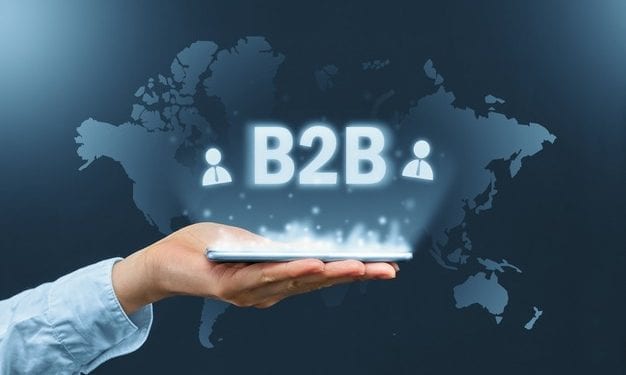The excitement and hype around Buy Now, Pay Later (BNPL) in the consumer world is undeniable. Affirm went public in early January with a market cap of about $24 billion. Klarna recently raised $1 billion and is now valued at over $30 billion. PayPal, AfterPay and a slew of other companies are also generating big buzz in the space.
Now, we are starting to hear rumblings of BNPL in the B2B world. And why not? The B2B eCommerce payment market — $4 trillion and growing — is ripe for transformation. Business buyers want the same digital experience they get as consumers and business merchants are looking for every opportunity to make their customer relationships stickier, increase average order size, and capture a larger share of wallet. The market is grossly underserved and there is a huge opportunity for the right solution.
Arguably more important is that small business buyers need access to affordable credit and financing options. Financing has always been a challenge for small and medium-sized businesses (SMBs), and COVID has only exacerbated the problem. According to the Biz2Credit Small Business Lending Index, overall loan approval rates in December 2020 were down over 50% vs. December 2019. Big banks only granted 13.1% of SME business loan applications vs. over 28.2% in December 2019. Over the same period, small bank lending dropped even more dramatically, from over 50.6% of loan requests to just 18.2%. It’s hard to know if such precipitous declines will ever reverse themselves.
In this environment, the need for liquidity and access to capital have never been greater. Small businesses need more flexible alternatives to traditional business loans that are better suited to their specific needs.
Solutions like Affirm, Klarna and others have dramatically expanded the ability for consumers to finance purchases – approaching 80% eligibility. These players may very well decide to turn their sights to B2B. But first, they, or anyone else targeting the space, have to adapt to the significant differences between B2C and B2B commerce.
Until COVID, a surprising percentage of B2B commerce still took place partially or entirely via traditional channels such as in-person sales, assisted selling, distributors, and phone. In fact, approximately 80% of B2B payments continue to be made via check. And 40% of businesses report that online purchases are more complicated to make than traditional purchases.
Not surprisingly, many B2B sellers were unprepared for the dramatic shift in customer preferences toward online purchasing (whether exclusively online or in conjunction with assisted selling). In addition, B2B-only sites have sometimes tended to function more as electronic catalogues than true selling engines.
Now, with the dramatic shift to online buying, the B2B merchant community has made strengthening their eCommerce presence a priority. But the ability to incorporate automated financing “in purchase” for B2B transactions is fundamentally different vis-a-vis BNPL for consumers:
- B2B customer relationships are significantly more complex. The marketing and selling process is longer and often involves multiple channels that include some level of managed sales. There is more customization in offerings and accompanying services. Account management and payment requirements are important components as well.
- SMB transactions that are financed tend to be larger (ranging from a few thousand dollars up to several million) than consumer purchases, which average closer to $1,000. Needless to say, the price of making the wrong financing decision is much higher.
- Approving financing for B2B purchases in real-time is highly complex. The array of data available to alternative lenders demands a specific type of risk-predicting expertise. The algorithms for approving consumer credit simply don’t apply.
- Larger purchases require more financing options – in terms of rates, length of time, payment schedule, etc. — and consideration of customer relationships, inventory turnover cycles and purchase history are important requirements.
- The fraud, legal, and compliance requirements are also more significant – from Know-Your-Customer (KYC) to Know-Your-Business (KYB) to Beneficial-Ownership (UBO). There are also prohibited industries.
- Integrations with financial systems and data reconciliation are more complex and mission-critical.
In-purchase financing (‘IPF’ for short) offers B2B merchants all the benefits of BNPL and much more, including:
- Seamless checkout experiences that improve the customer experience, increase average order value (AOV), and allow for money-saving automation for the merchant.
- Easy integration with existing systems. B2B merchants cannot afford disruptions to their business that involve high-ticket, key customer transactions
- Incorporating well-vetted underwriting and scoring models based on much broader datasets, business history and other predictive metrics.
- Serving the needs of all of the merchant’s business customers – small, medium and large.
- Teaching B2B merchants how to use different financing offers to sell more product, e.g., which terms drive the most action, higher average sales, etc.
The web is tailor-made for B2B commerce — always on, 24/7 availability, self-service, nearly unlimited choice. But when the customer is ready to buy, can they afford the cost? Do they have room on their personal or business credit card? Most businesses need another financing vehicle that can flex with their needs.
By automating the offering of in-purchase financing, B2B merchants have the opportunity to significantly enhance customer loyalty, increase average order value, reduce risk, streamline revenue recognition, improve cash flow, and create important operational efficiencies on the backend. Maybe most importantly, it frees B2B merchants up to focus on growing their business instead of managing payments and financing










